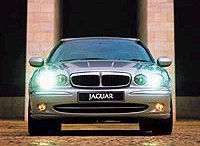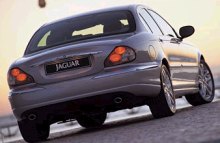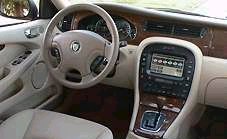|
Jaguar X-Type
Debut: 2001
Maker: Jaguar
Predecessor: no |
|
 For
the first time, the German domination of compact prestige sedan segment
(say, 3-series etc.) is going to end. Who can do that? not Rover, not
Volvo,
not Alfa, it is Jaguar. The car that will do that is called X-Type, a
typical
Jaguar name. For
the first time, the German domination of compact prestige sedan segment
(say, 3-series etc.) is going to end. Who can do that? not Rover, not
Volvo,
not Alfa, it is Jaguar. The car that will do that is called X-Type, a
typical
Jaguar name.
X-Type
has many
inherent
advantages over its German rivals. First of all, the British premium
marque
always has stronger image than BMW, Audi and - may I say -
Mercedes-Benz.
You need not to recall the glorious history of SS, XK120, C to E-Type,
MkII ... just look at the XJ sedan and you’ll feel the sense of
occasion
the big cat delivers. Here, X-Type is benefited from the corporate
image
as well as traditional styling cues. You can see its beautiful shape
combines
the best of various Jaguars, such as the grilles, headlights and
sculptured
bonnet of XJ, the side windows and C-pillars of S-Type and the tail
lights
of XK8 coupe. But just combining them is not enough, you need a great
tailor
like the late Geoff Lawson to merge them smoothly into a curvy, taut
body.
That’s not easy, especially there are a hell lot of features to be
shown
in the smaller body. The 4 circular headlamps, for example, are
difficult
to implement in style (see Mercedes E-class). Lawson was clever. He
compressed
the height of both grilles and headlamps, raised the bumper line thus
made
the nose slimmer. Yes, slimness is always the philosophy of Jaguar’s
traditional
styling, so Lawson decided to sacrifice a bit headroom in exchange for
a sleek streamline from nose to tail. Besides, to inject a sense of
sportiness
unfound in S-Type and XJ, he added extra muscle to the shoulder at
around
C-pillar. As a result, X-Type looks far sexier and far more
characterful
than any German rivals. It is also, if arguably, the best looking
modern
Jaguar.
 Predictably,
a mass-production Jaguar must share cost with Ford’s product, in this
case
is, Mondeo. I said it predictable because the S-Type is already doing
so
with Lincoln LS. Moreover, the new X-Type is produced in Ford’s
Halewood
plant in England, where Escort used to be assembled. However, the
decision
to base it on Mondeo platform is more a concern of development time
(slash
at least a year) instead of cost (we shall see later why). Basically,
the
Mondeo platform provides 20% common components, including front
MacPherson
struts and rear torsion-control multi-link setup. The front suspensions
employ twin-tube and twin-bearing. The rear is a space-saving design
coming
from the Mondeo estate. Strangely, as opposed to Jaguar’s tradition,
the
rear suspension was chosen to optimize luggage space to a remarkable
452
litres. In contrast, the wheelbase is shortened from 2754 to 2710 mm in
order to make the car smaller than S-Type. Predictably,
a mass-production Jaguar must share cost with Ford’s product, in this
case
is, Mondeo. I said it predictable because the S-Type is already doing
so
with Lincoln LS. Moreover, the new X-Type is produced in Ford’s
Halewood
plant in England, where Escort used to be assembled. However, the
decision
to base it on Mondeo platform is more a concern of development time
(slash
at least a year) instead of cost (we shall see later why). Basically,
the
Mondeo platform provides 20% common components, including front
MacPherson
struts and rear torsion-control multi-link setup. The front suspensions
employ twin-tube and twin-bearing. The rear is a space-saving design
coming
from the Mondeo estate. Strangely, as opposed to Jaguar’s tradition,
the
rear suspension was chosen to optimize luggage space to a remarkable
452
litres. In contrast, the wheelbase is shortened from 2754 to 2710 mm in
order to make the car smaller than S-Type.
Now comes the
problem: no
matter how brilliant the Mondeo chassis is, it is still a front-driver.
Question 1: can it cope with Jaguar’s bigger engines (3.0 V6 and then a
supercharged R model) and higher expectation ? unlikely; Question 2:
will
the public accept a premium sporty sedan - especially a Jaguar - to be
front-driver ? definitely not. That’s why Jaguar would rather add a
cost
of £900 and a weight of 80kg per car to make it 4-wheel drive. It
is a simple design employing epicyclic center differential and
viscous-coupling
LSD to direct 60% torque to the rear wheels in order to obtain a
rear-bias,
fun-to-handle character to match rivals. In case of wheelspin, viscous
coupler will lock up the differential thus send more torque to the axle
with more grip. You can see, this is a full-time 4WD like Audi (which
uses
Torsen LSD instead of VC), thus is superior to the part-time system
used
by Volvo and the LSD-less BMW xi models.
In
reality,
handling of this
Jaguar is eye-opening: what Audi’s quattro system learned in the past
20
years, Jaguar surpasses in its first attempt. Yes, yes, this baby
Jaguar
is as surefooted in any corners, any surfaces as the new A4 Quattro
while
being more entertaining to drive. It attacks corners confidently at
amazing
speed, displaying superior body control and balance while ride quality
is unexpectedly good. In mid-corner, it can be balanced easily on
throttle,
thanks to the rear-bias torque split. It let us wonder why Audi hasn’t
scrap its 50:50 Torsen system yet. At the limit, it will understeer
gently
like the Quattro to provide a secure characteristic that rarely needs
the
intervention of DSC.
Comparatively,
Audi is less
involving while rides far stiffer. Jaguar’s superior combination of
handling
and ride must thanks to the super-rigid body shell which is claimed to
be 30% stiffer than the "previous class leader" (implying 3-series).
Its
ride quality is at the firm side by Jaguar’s standard but excellent by
the standard of German marques. In fact, it is only bettered by
Mercedes
C-class.
The
ZF
speed-sensitive power
steering is another contribution to the great handling. Since the
S-Type
mid-life makeover, Wolfgang Reitzle did not allow Jaguar to use Ford’s
flawed steering rack again. 2.6-turn lock-to-lock is a good balance
between
directness and refinement. Admittedly, it is a bit inert at low speed
due
to the friction generated by the 4-wheel-drive, once up to 40 mph the
steering
is full of communication, again, more than Audi A4 Quattro. The
weighting
is just perfect, from light effort at parking, increase consistently
and
linearly as speed rise. As it isolates from vibration and unwanted
ground
intrusion very well, cruising can be done with just finger tips on the
steering wheel. The last goodness about steering is the lack of torque
steer, thanks to the unusual twin-bearing Mondeo front struts and
relatively
less torque driving through the front wheels.
 What
about C-class and 3-series? they might provide even better-informed
steering
and more entertaining power oversteer, but the Jaguar achieves better
balance
between sheer capability, confidence and entertainment. Its chassis is
world beating. What
about C-class and 3-series? they might provide even better-informed
steering
and more entertaining power oversteer, but the Jaguar achieves better
balance
between sheer capability, confidence and entertainment. Its chassis is
world beating.
Powering the
baby
Jaguar
is S-Type’s 3.0-litre V6, now re-rated to 231 hp perhaps because the
transverse
installation restricts a little bit breathing. Remind you, it is based
on Ford’s Cleveland V6 (powering Taurus) but is equipped with Jaguar’s
very advanced head (continuous intake VVT, 3-stage variable geometry
induction
manifold, electronic throttle) and 32-bit microprocessor, the last two
were designed to comply with Euro VI emission regulation to be
effective
in 2005. Remind you again, despite of these goodness, it used to be a
weak
link in S-Type. No matter what Jaguar say, such as 80% peak torque from
1500rpm, 90% from 2500rpm etc., it is still obviously a loser.
Remember,
a BMW 330i develops 90% of its 221 peak torque at 1500rpm, that equals
199lbft. In contrast, the Jaguar produces just 167lbft at the same rev.
No wonder the Jaguar V6 needs rev to realise its performance suggested
by the claimed 231 horsepower. Apart from mid-range torque, it is also
lack of the last 5% refinement. For instance, the engine gets booming
at
high rev, the throttle pedal has little response at its first half an
inch
of travel.
A
smaller,
2.5-litre V6 is
available as entry-level model. It is essentially a small-bore version
of the 3.0 unit. Power and torque are 194 hp and 180 lbft respectively.
Although its bore / stroke ratio is more healthy than the larger one
(which
is very oversquare at 89.0 x 79.5mm), their characters are similar.
Both
engines are smooth and quiet most of the time, but the lack of
instant-torque,
top-end refinement and a beautiful sound track send them to the second
class.
Lack of
fine-polishing is
also found in the 5-speed manual gearbox. Basically is Mondeo’s MTX-75
with some modifications. It is generally smooth (if heavy) and accurate
to shift, with short throw, but in a hurry it can be balky. Another
transmission
is a Ford 5-speed automatic with Jaguar’s unique J-gate shifter. It
suits
the 3.0 engine while blunting the performance of 2.5. No matter which
gearbox,
there is some driveline shunt occurs when stuck in traffic, which is in
common with other 4WD cars. In contrast, the braking system is
impressive
- powerful, fadeless and good pedal feel.
As for
performance, given
a lot of rev, mating with manual gearbox, both 2.5 and 3.0 achieve
remarkable
performance (see specification table below). In fact, the 3.0 is
quicker
than equivalent A4 and C320, just marginally edged out by the
fire-breathing
330i. Now I really believe it has 231 horsepower on tap. It will be
more
remarkable if you know that the super-stiff, 4WD-equipped Jaguar weighs
100 kg in excess of rivals !
 To
many Jaguar lovers, the best of Jaguar, besides exterior styling, is
the
leather-and-wood cabin. Having disappointed by the Ford-influenced
S-Type,
this baby Jaguar is not going to make the same mistakes. You’ll find
everywhere
is trimmed with leather and bird’s eye maple wood. The dials recessed
in
a wooden panel like some Saab. They are colored in British racing green
in a retro style. Center console is designed like that of XJ, but a
big,
7-inch LCD touch screen dominates it thus looks sophisticated. The
screen
provides a lot of functions, such as climate control, audio control,
navigation,
(optional) TV and mobile phone. As in other Jaguars, there is an
optional
voice activation too. Fit and finish of the cabin is up to standard,
but
there are two flaws: 1) the door panel looks dull. Why not incorporate
an elegant grab handle like that of Rover 75 ? 2) Low quality plastics
used. Actually no better than Mondeo. Luckily, most surfaces are
covered
with either leather or wood instead of plastics. To
many Jaguar lovers, the best of Jaguar, besides exterior styling, is
the
leather-and-wood cabin. Having disappointed by the Ford-influenced
S-Type,
this baby Jaguar is not going to make the same mistakes. You’ll find
everywhere
is trimmed with leather and bird’s eye maple wood. The dials recessed
in
a wooden panel like some Saab. They are colored in British racing green
in a retro style. Center console is designed like that of XJ, but a
big,
7-inch LCD touch screen dominates it thus looks sophisticated. The
screen
provides a lot of functions, such as climate control, audio control,
navigation,
(optional) TV and mobile phone. As in other Jaguars, there is an
optional
voice activation too. Fit and finish of the cabin is up to standard,
but
there are two flaws: 1) the door panel looks dull. Why not incorporate
an elegant grab handle like that of Rover 75 ? 2) Low quality plastics
used. Actually no better than Mondeo. Luckily, most surfaces are
covered
with either leather or wood instead of plastics.
Driving
position
is excellent,
with everything adjustable. Nevertheless, space is not its strength. To
preserve Jaguar’s traditional low roof line, front and rear headroom
are
sacrificed, especially the latter, where passengers of 5ft 10 (me !)
will
find touching the roof. What a pity. The rear legroom actually matches
3-series and A4, if not C-class.
In
short, the new
X-Type
is a far better attempt than S-Type to invade the segment used to be
dominated
by the German. In terms of styling, character and dynamic, it leaves
the
German rivals trailing. Had it got a real in-house-made engine, and a
little
bit extra effort in fine tuning, it would have been a clear class
winner,
a rare 6-star car in AutoZine’s verdict. Anyway, even without these
improvements,
the baby Jaguar is still a remarkable car. It seems that Jaguar’s sales
target of 100,000 units / year is too conservative. You know, BMW is
selling
some 450,000 Three-series this year. Halewood can build a maximum
140,000
cars annually. I think that will be easily exceeded when the X-Type get
a diesel V6 from PSA. |
| The
above report was last updated on 10 June,
2001. All Rights Reserved. |
X-Type 2.0
|
Inside
Jaguar, there was a strong argument whether they should build an
entry-level,
front-drive X-Type. The pro-side said they should not ignore the big
market
now being dominated by BMW 318i and Audi A4 2.0 or 1.8T. In Europe,
this
market is so big that BMW actually sells more 318i than any other
6-cylinder
3-Series. Ditto the A4. At the other end of boxing corner, the
against-side
pointed out that front-wheel-drive does not fit into the image of
Jaguar,
as the British marque has never built any front-driver in its 70 years
history.
Is this a good
reason for
rejecting new development ? If so, they should have already rejected
the
X-Type for its first-ever 4-wheel-drive system and transverse engine,
so
were the first V6 used in S-Type and V8 introduced to XK8 and XJ8.
Didn’t
people once say Jaguars should have straight-6 ?
In fact,
people
seemed rarely
care about through which wheels Audi A4 drive. The same goes for Alfa
156,
one of the most fun-to-drive car in the class. As long as the engine is
not too powerful, the latest FWD technology is good enough to provide
satisfying
handling.
To
Jaguar X-Type,
switching
to FWD is easy. Remember, its basic architecture was derived from the
front-drive
Ford Mondeo, therefore by employing more Mondeo bits at transmission
and
front suspensions the conversion was done at minimum cost.
Inside
the engine
bay, the
2.5-litre V6 has been de-stroked to 2099c.c. - oddly, Jaguar calls it a
2.0-litre. Power and torque drop to 156hp and 148lbft respectively,
more
than BMW 318i and level with the turbocharged A4 1.8T. Performance is
not
remarkable, but the smoothness and free-revving quality of the V6
certainly
makes the Jaguar feel classier than its four-cylinder rivals.
It should,
because it is
thirsty - a thing that matter to the buyers of this segment. Combined
cycle
fuel consumption is 30.7mpg, versus 34.5mpg of A4 1.8T and - thanks to
Valvetronic - 39.2mpg of 318i. With 2 more cylinders than rivals, the
V6
wastes more energy via thermal loss and frictional loss. There is no
free
lunch, you pay the price for superior engine refinement.
Devoid of 2
differentials
and drive shaft, in addition to the lighter engine, some 100kg was
eliminated
compare with the X-Type 2.5. Despite of this, at 1450kg, the baby Jag
is
still a heavyweight. On the other hand, the short-stroke V6 delivers
its
peak torque at a high 4100rpm, therefore to exploit good performance
need
an enthusiastic foot on throttle and a busy hand on shifter. Doing this
is a joy, thanks to the eager engine and positive gearshift. That said,
like other X-Types, the 2.0 encourages its driver to involve deeper.
Push it into
corners, the
baby X-Type feels like a grown-up Mondeo, where "grown-up" means better
damping and control over undulations. Its handling, balance and
steering
are as impressive as the Mondeo. Compare with 4WD version, you can
still
detect a touch more understeer at the limit. Torque steer, however, is
absent unless pushing hard in tight corners at low gear. Similarly, the
less torquey engine rarely pushes the car beyond its grip limit.
In
short, X-Type
2.0 handles
better than Audi A4 and nearly good enough to challenge the rear-drive
BMW 318i. The management made a correct decision: front-wheel-drive
works
in a Jaguar ! |
| The
above report was last updated on 18 Mar
2002. All Rights Reserved. |
|
|